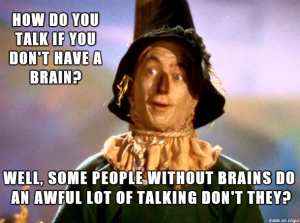Quite simply, in media one this week we looked at stories. What makes a story? Why do we tell them? Is everything a story, or can a media text be entirely story free? These were the questions brought up by tutor and as-it-turns-out-hilarious lecturer Daniel Binns.
At school, you get taught that stories are most simply made up of a beginning, middle and end, and looking at it pretty basically, that’s true of most media (or at least Western media). But Daniel took things a step further by exploring the idea of causality (what we in year twelve media called ‘the story element cause and effect’). Causality is pretty much as simple as it sounds: it’s the idea that one event causes another, and that in turn causes another and so on and so forth. In media, this concept – while on the surface painfully obvious – is really important to think about in depth because it constitutes the way in which we develop traditional narratives.
Daniel broke the idea of ‘causality’ in narrative media down into three parts: plot, resolution and character development. These are three key elements of narrative media that demonstrate the importance of causality.
The first of these, plot, should be fairly obvious. Causality is how we progress plots – in our primary school scheme, causality fills in the middle between the beginning and end. The Wizard of Oz would be pretty boring if we started with Dorothy arriving in Oz and then moved straight onto her getting home; in the middle we have the plot, which is made up of a chain of linked events. Dorothy accidently kills The Wicked Witch of the East, which leads to her being pursued by The Wicked Witch of the West, which leads to her being sent down the yellow brick road, etc, etc, until finally she finds the Wizard and can return home.
Which brings us to the second point: resolution. As Daniel put it, the resolution of a plot relies on causality not just because it is the last in the chain of linked events, but because it is the resolution of everything that has happened in the film. At the end of The Wizard of Oz, not only does Dorothy return home, but her companions get their wishes, the Wizard finds redemption, Toto is saved, and then absolutely everything is resolved in the neat (and rather frustrating, if you ask me) conclusion that ‘it was all just a dream’. The point is, this plot resolution was caused not just by the event directly preceding it, but all the major plot points of the film. Thus, causality is not just important in telling a story that moves from event to event (the plot), but in telling a story that follows the satisfyingly familiar Western story structure of opening, development and resolution (the year twelve media way of saying beginning, middle and end).
Finally, character development. Daniel brought up a classic storytelling phrase when explaining this point: ‘show don’t tell’. We all get told in creative writing classes to use techniques to create our characters rather than openly describing them, for example, “he squinted, his eyes adjusting to the dawn light filtering through his unusually non-bespectacled eyes” is preferable to “he couldn’t see without his glasses”. (Give me a break, I made it up on the spot.) In narrative media (for argument’s sake let’s restrict it to film and TV), this means using techniques – such as story – to highlight the characters’ attributes. For example, in The Wizard of Oz . . . oh wait . . .
Not a great example of show don’t tell. Let’s look at X-Men (the first one). When Rogue being lost and alone leads to Logan (Wolverine) taking her in, we don’t need a narrator to tell us that beneath his steely exterior (hardy-har-har), wolverine has a heart of gold.
So stories are pretty important. In fact, I’m getting distracted by one right now, so I’d better head off!
